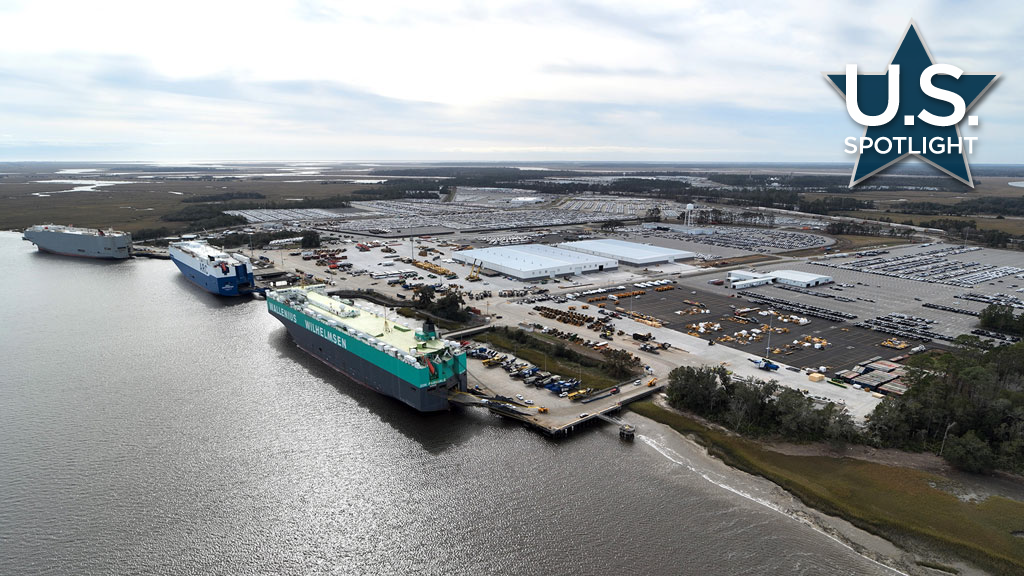The Georgia Ports Authority (GPA) is forking out $4.5 billion on a number of large projects at gateways in Savannah and Brunswick over the next 10 years that will lay the foundation for the future.
The funds are part of a master plan that was approved by the GPA to expand cargo handling capabilities and support future supply chain requirements.
The investment is over and above the $3.27 billion that’s already been spent on new port and inland infrastructure since 2012.
The projects will take place at various locations and enable the ports to double berth capacity and increase yard and rail volume. The ports will move to a capacity of 12 million TEUs from seven million.
GPA president and CEO Griff Lynch told the Georgia International Trade Conference recently the investments are going into projects that enhance the four key components of a successful port operation: berth space, yard capacity, trucking gate fluidity and intermodal connectivity.
“We are always focused on growth,” he said. “We want to go above and beyond to build a port that handles both future growth and supply chain disruption. We are creating a safe, trusted harbor for your cargo. Leadership is being able to see what’s coming and staying ahead of it.
“At the Georgia Ports, we are building a resilient link in the global logistics chain, one that is ready to withstand any future challenges.”
The plan is aggressive, but will enable the GPA to boost rail capacity, upgrade docks and cranes, add new space for auto processing, and enhance the operations of its main terminals.
At the Port of Brunswick, which has three deepwater terminals, a fourth berth and another 50 acres of paved vehicle storage are being added at the Colonel’s Island Terminal. The enhancements will complement 120 acres of paved storage and warehousing that were added recently at a cost of $262 million. The roll-on/roll-off port is one of the fastest growing auto and heavy machinery ports in North America and is presently used by 12 major auto companies.
The new ship berth is currently in the engineering phase. It will more efficiently accommodate modern vessels and be capable of handling 7,000-plus vehicles.
The expansion, to be completed next summer, will make the Port of Brunswick the nation’s largest auto port and allow the GPA to more efficiently accommodate increased trade crossing the docks. In the last fiscal year, which ended in June, the terminal handled more than 870,000 units. When fully complete, annual capacity will reach 1.4 million units for a 40-per-cent increase.
The port’s growth has been driven by a population surge, and “comes in response to requests from auto manufacturers seeking to expand their cargo volumes through Georgia,” said Lynch.
The state is growing three times faster than the U.S. population. More distribution centres and auto manufacturing companies like Hyundai are targeting the region as an attractive place to expand their enterprises.
Improvements to the terminal will also be accompanied by dredging and other improvement projects to be done by the U.S. Army Corps of Engineers at Brunswick Harbor. The work is expected to start by the end of the year. Nearly $38 million in federal funding is earmarked for the project, with $26.6 million going towards returning the federal waterway to its full authorized depth.
Another $11.35 million in federal funds and $6 million in state funds will be used to increase the safety and efficiency of vessel transit through the river channel. The plan includes an expanded area for vessels to pass each other, a bend widener and an expanded turning basin for ships.
A renovation project at Ocean Terminal in Savannah is expected to start in 2027 and be completed by 2028. The project will transform the current three small-berth facility into two big ship berths.
A new, $29-million exit ramp for truckers will provide direct access to Route 17 which means trucks will avoid going through local neighbourhoods.
The Talmadge River bridge over the Savannah River will be heightened by 2028 to allow larger container ships into the port. A future container terminal on Hutchison Island will create three new big ship berths.
Meanwhile, construction has started on a larger, new, $44.5-million U.S. Customs inspection facility at the Port of Savannah that will transform the existing 130,000-square-foot structure into a 300,000-square-foot building. The building will accommodate customs and other federal agencies such as the U.S. Department of Agriculture and the U.S. Fish and Wildlife Service.
New dock upgrades are also scheduled to improve safety and capacity and ensure Savannah can efficiently serve the largest container ships serving the U.S. East Coast. The current dock infrastructure is more than 50 years old. �鶹��ý����ion is anticipated to start in late 2025.
At Savannah, a previously completed rail project at Garden City Terminal has doubled rail lift capacity to two million 20-foot equivalent container units per year. The massive rail expansion enables the port to capture additional market territory through direct service to population centres across the Midwest U.S.











Recent Comments
comments for this post are closed